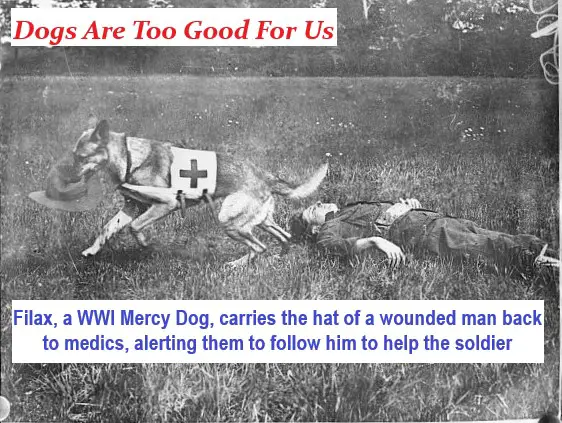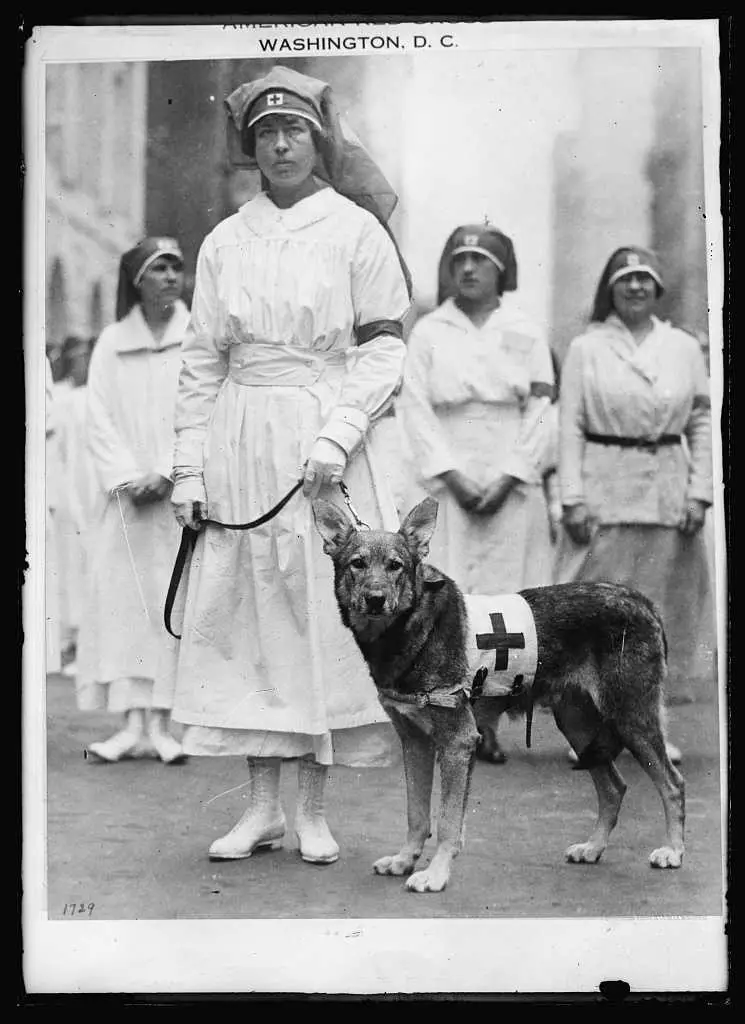
Dogs are too good for us. Throughout history, people have asked dogs to perform dangerous duties with the goal of risking canine lives in place of human lives. Dogs have answered with courage and loyalty.
The photograph above entitled, “Dogs in Humanity’s Service” a World War One Red Cross dog named “Filax” is shown carrying the hat of a wounded soldier to find stretcher bearers who will attend to the injured man.1
It is estimated that by the conclusion of the First World War, there were 10,000 dogs serving at the Western Front and at least 7,000 had died in active service during the war. “They were on the front lines, dashing across No Man’s Land, carrying messages, or searching for the wounded. They hauled machine guns, light artillery, and carts loaded with ammunition, food, medicine, and sometimes wounded soldiers. Small dogs trotted among the trenches, delivering cigarettes and comfort.”2
Dogs like Filax were also known as “Mercy Dogs.” The Red Cross dogs were “first taught to distinguish between the uniforms of the soldiers of their own country and those of the enemy. Then they learn that the principal business in life for them is to find and ais wounded soldiers. The animals are trained to search without barking and to return to headquarters and urge their trainers to follow them with stretcher bearers. Sometimes the dogs bring back such as article as a cap, tobacco pouch or handkerchief.”3
National Geographic reported on how Filax found his way to the battlefields of France. “Filax, a sheep dog, failed to win a prize at the New York dog show a few years ago, being pronounced ‘somewhat too coarse for show purposes.” His master thereupon put him into Red Cross Work. Braving the dangers of No Man’s Land on innumerable occasions, he saved the lives of a hundred wounded French soldiers.”4 Note: in those days shepherds were sometimes simply called sheep dogs.
Flax’s owners, Mr. and Mrs. Leo F. Wanner of Hempstead, Long Island were well known as breeders of champion Belgian shepherds. Mrs. Wanner was an avid supporter of Red Cross ambulance dogs5 and Mr. Wanner had personally contacted the U.S. Secretary of War advocating for the formal mobilization of dogs for the U.S. Army and offered 20 of his own trained dogs for war work.6
One of Filax’s more notable rescues is described in this way:
“A French lieutenant, in command of a raiding party, fell into a German trap, with the result that his command was cut to pieces. He himself was so badly wounded that he was unable to regain his own trenches. He dragged himself down a declivity, and lay at full length behind a boulder, where the searchers for the wounded overlooked him. When he fell his helmet rolled off and in some manner was hidden under his doubled-up body. There he remained, and there he would have died, if Filax, on one of his scouting expeditions, had not found him. The dog looked in vain for the helmet, and not finding it, squatted upon his haunches and slowly, methodically, licked the face of the unconscious soldier. This must have acted as a restorative, for presently the wounded man opened his eyes, and seeing what manner of visitor had come to him, pulled out the helmet from under his body and gave it to the dog. Shortly after a rescue party, headed by the indomitable Filax, found him and brought him in.”7
Filax served for over a year at the Western Front and was wounded twice.8 He was brought back to the United States and was put to work raising money for the Red Cross. He is seen in the photograph here at a Red Cross Parade with Mrs. Leon Wanner.9

Filax returned to the show ring at Madison Square Garden in 1917 as part of an exhibition of war dogs to raise money for the American Field Ambulance Corps.10 A New York Times headline proclaimed, “War Hero is Lauded By Dog Show Crowd: Filax of Lewanno is Popular Entry on Second Day of Garden Exhibit.” 11 Here is how the Times reported his appearance:
“Where is the war dog?” was the general inquiry of visitors at Madison Square Garden yesterday for the second day of the Westminster Kennel Club show. The distinction won by Filax of Lewanno because he had rescued fifty-four wounded soldiers from the trenches had placed him in a class by himself, and the sturdy German shepherd dog yesterday monopolized the attention of the casual spectators who cared more for the glamour surrounding a war hero than they did for the aristocrats of dogdom which had earned their spurs by countless victories in the show ring. There was some satisfaction for these hero worshippers when they found that Filax of Lewanno was decorated with three red ribbons, that had been awarded by Judge Charles G. Hopton, because of his excellence as a German shepherd dog.”11
Sadly, one year after his triumph at Westminster, Filax died just two months shy of his 6th birthday along with a half dozen other dogs when a fire destroyed the Wanner’s kennel in Hempstead Long island. The New York Times article about the fire simply stated that “Filax had seen service in France and had been wounded. He was sent to this country to aid in the first Red Cross drive and was instrumental in raising over $3,000.”12 The Times article felt more focused on the monetary value of the kennel’s loss (Filax himself valued at $4,000 while all 7 dogs and the kennels were valued at over $25,000).12 It would be impossible to place a value on the lives saved at the Western Front by Filax’s “service in France.”
I hope readers will not be too critical of some inconsistencies in these various accounts from a century ago…exactly what kind of shepherd was Filax? …how many soldiers did Filax save? …was the photo of Filax carrying a soldier’s helmet on the battlefield or was did it show him in training?
My goal in sharing Filax now is to remind us of the courageous dedication of dogs like him that continues today whether the dogs are serving alongside soldiers, law enforcement, rescue squads, or in countless other canine professions. They are good to us, sometimes too good…
—R.A. Kroft
Sources:
1Dogs in Humanity’s Service (no. 708). American National Red Cross photograph collection (U.S. Library of Congress), Published December 1917. No known restrictions on publication.
2Bovsun, Mara. All K-9s on the Western Front. American Kennel Club (AKC) Gazette. November 2007, p. 45.
3Miller, Kelly. History of the World War for Human Rights. A. Jenkins publisher, 1919, p. 204
4Baynes, Ernest Harold. “The Sagacity and Courage of Dogs: Instances of the Remarkable Intelligence of Man’s Best Friend Among Dumb Animals.” The National Geographic Magazine, March 1919, 264.
5Dogdom, “America’s Greatest Dog Magazine.” March, 1920.
6Army of Dogs for the United States Urged. El Paso Herald, May 8, 1917.
7“Filax,” Friend of the Soldier. Washington News Letter. Volume 23, October 1917, p. 300.
8Carmichael, Jacqueline Larson. “Gentleman in Fur.” Heard Amid the Guns: True Stories from the Western Front, 1914-1918. Heritage House Publishing Co., November 3, 2020, p. 182-183.
9 War dog feature of Red Cross Parade. Mrs. Leo Wanner, and her Red Cross dog, “Filax,” one of the features of the great Red Cross parade in New York, Oct. 4. (LC-A6196- 1729 American National Red Cross photograph collection (U.S. Library of Congress). No known restrictions on publication.
10German Sheepdogs: Shepherd Dog Club of America Show. The Dog Fancier, Volume 27, January 1918, p. 14
11 “War Hero is Lauded By Dog Show Crowd: Filax of Lewanno is Popular Entry on Second Day of Garden Exhibit.” New York Times. February 22, 1917, p. 12.
127 Valuable Dogs Perish: Fire Destroys Mrs. Leo Wanner’s Kennels at Meadowbrook, L.I. New York Times. May 20, 1918, p. 17.
R.A. Kroft writes about her day-to-day journey in living a smaller, more sustainable life and other topics that interest her.

This Site Was Inspired By An Interest in Protecting the Environment:
We had the privilege and joy of learning from Dr. Charlie Stine who instilled a love for the natural world through incredible field trips with the Johns Hopkins Odyssey Certificate program in Environmental Studies. At the time, the program was endorsed by the Maryland Department of Natural Resources. Sadly, after Dr. Stine retired, the program was phased out. We hope that we honor his legacy by shining a bright light on environmental issues and sharing good news about the success of various conservation programs when possible.
